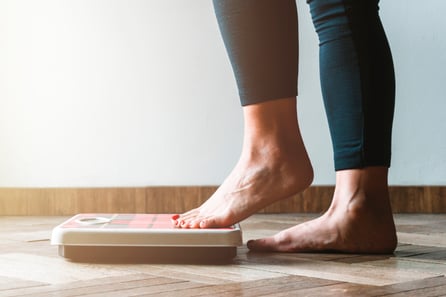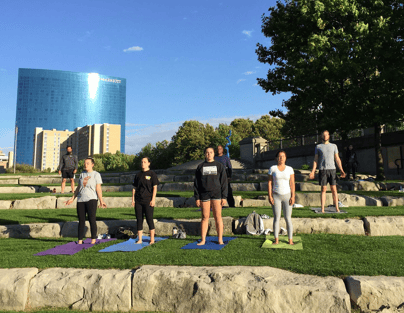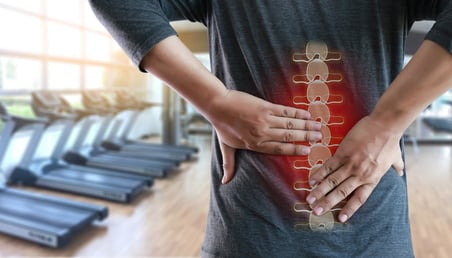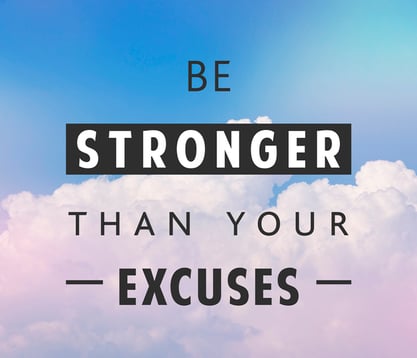Mental health is directly connected and dynamically influenced by our activity levels and our physical health. Why is this?
.jpg?width=335&height=223&name=GettyImages-2193875040%20(1).jpg) Physical activity is an integral part of keeping your body, mind, and spirit healthy. Regular physical activity supports cardiovascular health, bone density, muscle mass, disease prevention, and numerous other health benefits. How else does physical activity benefit us?
Physical activity is an integral part of keeping your body, mind, and spirit healthy. Regular physical activity supports cardiovascular health, bone density, muscle mass, disease prevention, and numerous other health benefits. How else does physical activity benefit us?
Stimulus and Our Brains’ Stress Responses
Physical activity stimulates both the Central Nervous System (CNS) and our Peripheral Nervous System (PNS) with signals about our environment, what we feel, our movement control, and our bodily functions.
Our incredible brains respond with what we call sympathetic and parasympathetic feedback responses. These signals regulate everything our body does. Without these signals coming to and from our brain and spinal cord, we wouldn’t react or function in any sense.
Sympathetic responses are related to stress and our “fight or flight” state. When we wake up, get nervous, or experience adrenaline, we release hormones like cortisol that activate our bodies to be ready for action. In these states, we breathe faster and start to divert most of our blood flow toward our muscles and extremities. We also typically do not have focused attention and are heightened in our awareness of everything. We may become hyperalert, agitated, and uncomfortable. These states are useful in short bouts during our daily lives.
Parasympathetic responses are related to our “rest and recover” states that allow us to calm down and return to our natural baseline. During these responses, we release hormones like acetylcholine that have relaxing and calming effects on all of our systems. Blood flow is more uniform across the entire body, and we feel at ease. We can offer more attention to fine details and think with greater clarity. We also experience sensations of hunger, tiredness, and contentment. This state supports our long-term health by ensuring our nutrition and sleep needs are addressed.
Progression into poor states of mental well-being can be common when people become sedentary and don’t stimulate themselves with movement. Life’s stresses can accumulate, and in serious cases, people can develop depression, anxiety, and other concerns when they can’t self-regulate their sympathetic responses. What can we do to help support healthy responses to stress?
Physical Activity and Exercise – “Controlled Stress”
Physical activity benefits us by allowing our mind to release stress (reducing levels of hormones like cortisol) as we condition ourselves to relax after stress and exertion. When we engage in physical activity, we create a stress stimulus, and in response, our body releases catecholamines such as endorphins, epinephrine, and norepinephrine.
The Mental Wellness Benefits of Physical Activity
Exercise is simply structured physical activity. When we engage in physical activity, we expose ourselves to a controlled amount of physical stress that can lead to long-term adaptations, as well as short-term benefits. Common benefits that result from exercise include lower blood pressure, better insulin sensitivity, increased muscle mass, increased bone density, and increased stroke volume.
Our mental performance and focus can benefit from dopamine release influenced by physical activity. Some studies document short-term cognitive improvements in both working and episodic memory. Short-term focus and attention can be improved for hours after bouts of physical activity. Retention of long-term memory from working memory may also be enhanced as we transition through stages of sleep. This means that we may retain more information in our daily activities after physical activity and thus improve our ability to learn.
Another important mental benefit of physical activity is decreased stress levels due to lowered cortisol. This hormone can increase your blood pressure, disrupt digestion, cause depression, weight gain, and sleep issues. When we exercise, we allow our body to release catecholamines and reduce cortisol levels in the blood. This is one of the reasons we feel better immediately after exercise. Afterward, it’s common to experience lower blood pressure, feelings of contentment, achievement, and overall calmness.
One final benefit that is crucial to mention is improved sleep quality. Lower cortisol levels can help prevent or improve sleep disruptions and difficulty falling asleep. The combination of energy expenditure and hormonal responses following exercise enhances our sleep quality.
Why Not Engage in Physical Activity?
Exercise is a form of medicine that proactively improves our mind, body, and spirit. We can see improved stress response and management, enhanced focus and clarity, and better emotional well-being. Why wouldn’t you want to do something that can improve the quality of your life so dramatically?
Not sure where to start? Meet with a NIFS personal trainer to help you reach your goals!


 It’s no secret that our emotions impact what we eat, when we eat, and how much we eat. In fact, sometimes it seems that the strongest cravings hit when our emotional and mental well-being is at its weakest. Emotional eating is a way to, in the short term, relieve or suppress negative feelings, such as sadness, stress, anger/frustration, or boredom. However, emotional eating can also lead people to make poor choices, such as skipping or forgetting meals, consuming fast food frequently, or consuming alcohol or caffeine in excess, all of which may have health consequences, including unintentional weight gain.
It’s no secret that our emotions impact what we eat, when we eat, and how much we eat. In fact, sometimes it seems that the strongest cravings hit when our emotional and mental well-being is at its weakest. Emotional eating is a way to, in the short term, relieve or suppress negative feelings, such as sadness, stress, anger/frustration, or boredom. However, emotional eating can also lead people to make poor choices, such as skipping or forgetting meals, consuming fast food frequently, or consuming alcohol or caffeine in excess, all of which may have health consequences, including unintentional weight gain. 
 According to the
According to the 
 Raise your hand if you’ve been here before: You get to the end of a great workout. You’re spent, fatigued, but in a good way. In a way that you know you’ve put in some quality work. But you look down at your watch and realize you’ve run a bit over your time. So you grab your things and rush out of the gym. You don’t have time for a cool-down, right? You’ve got to get to the car and rush to the next thing on the docket.
Raise your hand if you’ve been here before: You get to the end of a great workout. You’re spent, fatigued, but in a good way. In a way that you know you’ve put in some quality work. But you look down at your watch and realize you’ve run a bit over your time. So you grab your things and rush out of the gym. You don’t have time for a cool-down, right? You’ve got to get to the car and rush to the next thing on the docket. 
 Do you want to be part of a community and hold yourself accountable while working out? Group fitness classes just might have what you are looking for!
Do you want to be part of a community and hold yourself accountable while working out? Group fitness classes just might have what you are looking for! 
 Today, the realities of the human body immediately after giving birth are less mysterious than ever, a development some attribute to a changing climate around motherhood. In the past women felt like they couldn’t talk about the after-effects of having a baby, let alone caring for other children at the same time.
Today, the realities of the human body immediately after giving birth are less mysterious than ever, a development some attribute to a changing climate around motherhood. In the past women felt like they couldn’t talk about the after-effects of having a baby, let alone caring for other children at the same time.  Picture this: You’re sitting in the car, in stop-and-go traffic. Your mood is just shot and all you want to do is get home. Now try this: Turn up the volume on your radio and let the music take over your soul!
Picture this: You’re sitting in the car, in stop-and-go traffic. Your mood is just shot and all you want to do is get home. Now try this: Turn up the volume on your radio and let the music take over your soul!  Take these next few weeks or so and use them to your advantage. We know this is an extremely challenging time, and we want to make sure you feel like you are taken care of. Circumstances are tricky right now, so even if you adopt one new technique, consider that a win! Don’t expect yourself to “eat the rainbow” every day, feel like you fall asleep easily at night from a relaxing day working at home in your pajamas, or get in a 10-mile run each morning. While you shelter at home and stay healthy, keep these tips in mind.
Take these next few weeks or so and use them to your advantage. We know this is an extremely challenging time, and we want to make sure you feel like you are taken care of. Circumstances are tricky right now, so even if you adopt one new technique, consider that a win! Don’t expect yourself to “eat the rainbow” every day, feel like you fall asleep easily at night from a relaxing day working at home in your pajamas, or get in a 10-mile run each morning. While you shelter at home and stay healthy, keep these tips in mind. With millions of people around the world suffering from back pain, is there any hope for relief outside of traditional methods? Low back pain can be excruciating and immobilizing, but there is still hope. When dealing with any pain or injury, exercising might be the last thing that crosses your mind, especially if it’s chronic low back pain (CLBP). However, that’s exactly what is recommended and what can help.
With millions of people around the world suffering from back pain, is there any hope for relief outside of traditional methods? Low back pain can be excruciating and immobilizing, but there is still hope. When dealing with any pain or injury, exercising might be the last thing that crosses your mind, especially if it’s chronic low back pain (CLBP). However, that’s exactly what is recommended and what can help. What’s your motivation for working out? Eat healthy? What’s your motivation to get enough sleep or practice de-stressing with yoga or foam rolling? What’s your motive to get your friends and family to go on a walk or to the gym with you?
What’s your motivation for working out? Eat healthy? What’s your motivation to get enough sleep or practice de-stressing with yoga or foam rolling? What’s your motive to get your friends and family to go on a walk or to the gym with you?